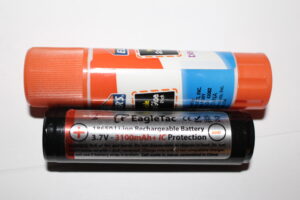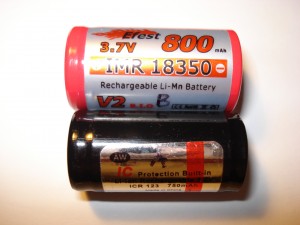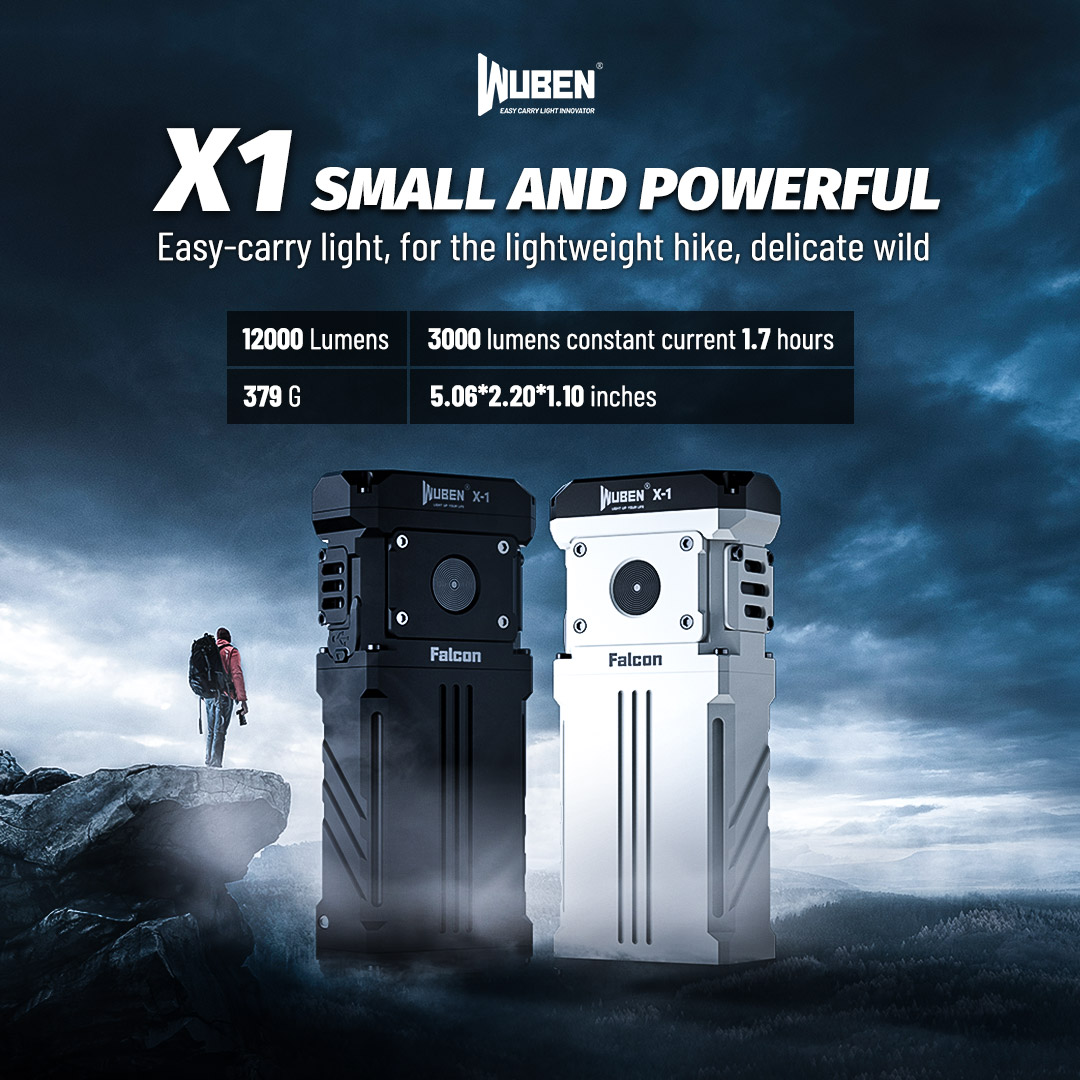Are you among the many who have found lithium ion batteries to be both a powerful and economical choice for a variety of products? But how knowledgeable are you when it comes to lithium-ion battery care? This is important because if you’re a new user, there are several do’s and dont’s when it comes to these ‘possibly’ dangerous tools.

A typical 18650 battery compared in size to a typical glue stick!
The focus here is on rechargeable batteries. Primary (non-rechargeable) lithium’s still carry their warnings, as do ALL batteries for that matter, but it’s when the hazardous chemicals housed within the cell need to be rejuvenated, that a few precautions should be followed.
As long as you’re buying protected cells, you shouldn’t have to worry about the battery discharging too much while in use. The built-in circuit will cut the power around 3.2 volts. It’s a good habit though to periodically check the voltage of the cell. Many users agree that a lithium battery shouldn’t routinely be discharged to the point of automatic termination. This can shorten the life of the cell.
1/ The First Rule of Charging
Once you’re into the rhythm of regular recharging, there’s not much to think about. One thing you SHOULD have though is a digital multimeter, for the purpose of testing the voltage on your lithium batteries. It’s recommended that this be done before and after you charge your cells.
When purchasing a battery charger, make sure the unit features a CC/CV (constant current/constant voltage) method of charging. Some cheaper chargers tend to overcharge the cells. Lithium batteries have the potential to be dangerous if regularly mishandled. Should they become hot while charging, they can physically catch fire. It’s advised to always monitor your cells during a charging cycle, and not to leave them completely alone in case the charger detects a problem. Also, make a habit of removing the cells from the charger soon after they’re full.
Another important precaution when caring for your lithium batteries is to make absolutely certain when using two cells in a device at once, that they be of relatively equal charge when installed. Although stories of fire and/or explosions are rare, there’s a greater risk to such dangers when using two unevenly charged batteries in series (ie; end to end). Don’t run the risk of potentially holding a mini pipe bomb in your hands!
2/ The Lithium-ion Advantage
One of the many advantages of lithium batteries is that once fully charged, they keep 80% of their power for up to a year.
Say for instance you were using a device which contained a rechargeable battery, and suddenly were to lose it. Even if after several months you found it again, the battery would still be safe to charge IF the voltage were above 3 volts. If on the other hand it had drained to below 2.7 volts…then it’s advisable to toss it. Some chargers however will still be able to revive it without issue.
If you over-buy rechargeable lithium’s, and leave them sitting idle for several months at a time, then you might consider a long-term storage plan. This is because when sitting charged for long periods without use, (as in the example of losing one) the cell will deteriorate at a quicker rate than if kept in regular use.
3/ Long Term Storage
It’s recommended that for months of non-use, the cell be discharged to roughly 50% of its total capacity. This usually equates to roughly 3.8 volts. The cell would then be placed in an air tight plastic bag and placed in the refrigerator. It should keep well under these circumstances almost indefinitely. Then when you’re ready to place it back in service, remove it from its chilling state, allow it to get to room temperature, and charge it up! It’s important to NEVER store a lithium battery below 32°F (0 Celsius)! And when entering its storage phase, be sure that the voltage be between 3.6 and 4.0 volts.
4/ WARNING! (if you buy from a discount merchant)
When you buy new cells, it’s advised to always check the voltage with a multimeter. If you buy quality brand-name cells, chances are they’re already partially charged.
If you go the “cheap” cell route from a discount merchant (on Amazon for instance) there’s a good chance your batteries might arrive dead! What I mean by that is the cells might register somewhere between 1.0 and 3.0 volts. If this is the case they could be old, used, and/or recycled product!
Discount sellers will buy batteries in bulk. Often, they’re factory rejects! The merchant doesn’t know in advance what condition the batteries are in! There’s a chance (albeit small?) that these batteries could be dangerous if you attempted to charge them!! In this condition, they should be returned for a refund. Old, over-discharged batteries have been known to “vent with flame” either in the charger, or in the device itself.
5/ When Cheap Batteries Can be Hazardous!
‘Vent with flame’ basically means that if a serious short were to occur within the cell, the chemicals could vent (which are harmful to breathe in by the way), possibly followed by flames!
If a battery is in the middle of a charge and becomes hot…unplug the charger immediately!
If while holding a flashlight, and the body (of the light) gets very hot…drop it, and move as far away from it as you can. Just in case.
Check out this dramatic video:
UltraFire is one of the cheapest, and most UN-trusted brands available. The same rule goes for cheap lithium chargers as well.
…and finally…Don’t Be Afraid, Just Be Safe
Please don’t let some of the warnings discussed here, scare you away from rechargeable batteries. I’ve been using them for years and have had no issues! BUT… I only buy reputable cells!! I keep them in sealed battery cases between uses. And although I try not to let them run down completely during use, it has happened on many occasions.
When learning about lithium-ion battery care, it’s really all about common sense. Keep in mind one thing though; lithium batteries (in general) are NOT considered consumer items. This is one reason why rechargeable lithium batteries are not sold in stores. Most of the time they’re only used as part of a battery pack, either in laptop computers or power tools for example.
It’s from the popularity of LED flashlights and electronic cigarettes that lithium cells have found their way into the hands of average consumers.
Rechargeable lithium-ion batteries are economical and last a long time. Just be smart and safe when putting them to use.
This link will take you to a page of good quality 18650 battery brands.
Have questions or comments? I’m here to help…just fill in the form below.







I would like to order some 14500 batteries and charger. I would like to get discount batteries do to a limited budget. After reading your post and viewing the videos I’m very hesitant. Can you recommend a reasonable battery/charger combo that you consider safe?
Hi Ken!
Are you talking about some of MY videos? I’ve reviewed some capable chargers before, and they’re all listed within the articles here at Lightsngear! One of the recent ones I reviewed, the MiBoxer C2 is not available on Amazon or eBay yet, but I CAN recommend a new Nitecore charger…the i2. With two slots, it can charge all types of rechargeable batteries. Here’s a link for it — http://amzn.to/2oJ423S Please understand that you CANNOT buy battery and charger combos! The only ones you might see, are not safe to use.
For 14500 batteries, I can recommend several brands. Efest, Nitecore and Olight.
Corrected typos-
One thing that should be mentioned in battery safety is the wrap. If you purchase flat-top unprotected cells this is important.
From my understanding protected cells have a thicker wrap added as well as the circuit and button top. That’s why the diameter and length of these batteries vary.
The numbers tell you the size. The 18 means 18mm Outside diameter and the 650 is t65mm in length, to name the main sizes
-18650 = 18mm od x 65mm long
-16340 = 16mm od x 34mm long
-14500 =14mm od x 50 mm long
-18350 = 18mm od x 35mm long.
Since most manufacturers rewrap cells for branding and protection these measurements can vary. It’s also why some batteries will fit and some will not. Back to safety. There are 4 major manufacturers you can trust for 18650 cells. The other batteries you find most likely are rewraps of one of these. Possibly a reject or old cell. Not saying they are rejects but this is why the ratings can be inflated or you receive bad/dead cells and why the cheap bargain combos stated above are bad. The main manufacturers of good reliable li-ion cells are lG, Sony, Samsung and Panasonic. Other good makers are sanyo and nitecore for smaller sizes. For recommendations look up “mooch’s recommended “ on google.
The wrapping is what protects the cell from shorting. So if there is a tear on the side or on the positive end a short can happen, which we all know is bad. That’s why is bad to keep batteries loose in your pocket or bag and not in a protective case. This practice will cause tearing and may also create a short by having a connection made of the positive and negative. On the positive end, the flat top is positive and the rest of the battery is negative. So if the wrapping is torn and something connects the two it shorts. The wrapping and end cap ring is the only thing helping this to be Prevented. It’s easy and to rewrap your own unprotected batteries (I only buy unprotected flattops). It costs pennies and it’s just a plastic tube that you put around the cell after you remove the old one (don’t use anything metal to remove the old wrapper). And it shrinks tight with heat from a blow dryer. These li-ion rechargeable batteries last years but the thin wrapper will not. So it’s always good practice to inspect your wrapper and replace it when tears are found. If you don’t feel comfortable doing this then buy new cells. If not your asking for trouble.
Thank you!
Great information! Thanks for the tips regarding the wrappers.
Hi – your link to a TRUSTED 18650 battery brand takes me to an Amazon page with lots and lots of different batteries – which is the one you trust?
Thanks Edie!
I might have to change that link! Not everything there is 100% “trusted”. Among the best, are Orbtronic, Keeppower, and the Ncr18650B.
Oh your “TRUSTED 18650 battery brand. Guaranteed!!” Link takes me to an Amazon page selling one of the “most UN-trusted brands” UltraFire” and they are certainly not the cheapest brand ? also what is 32 degrees?? Thankfully I know the answer but I pity those storing their batteries in the heating cupboard at over 30 degrees Celsius ?
Thanks for the info!! Keeping up with Amazon links is a job in itself! I have since UPDATED the link. Thanks for pointing out the temperature faux pas – which too has been clarified.